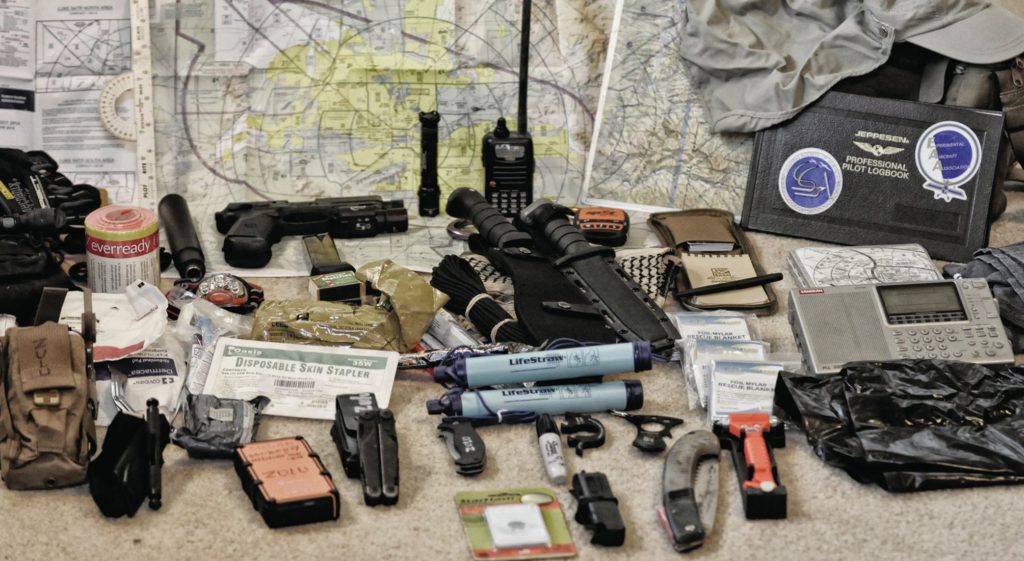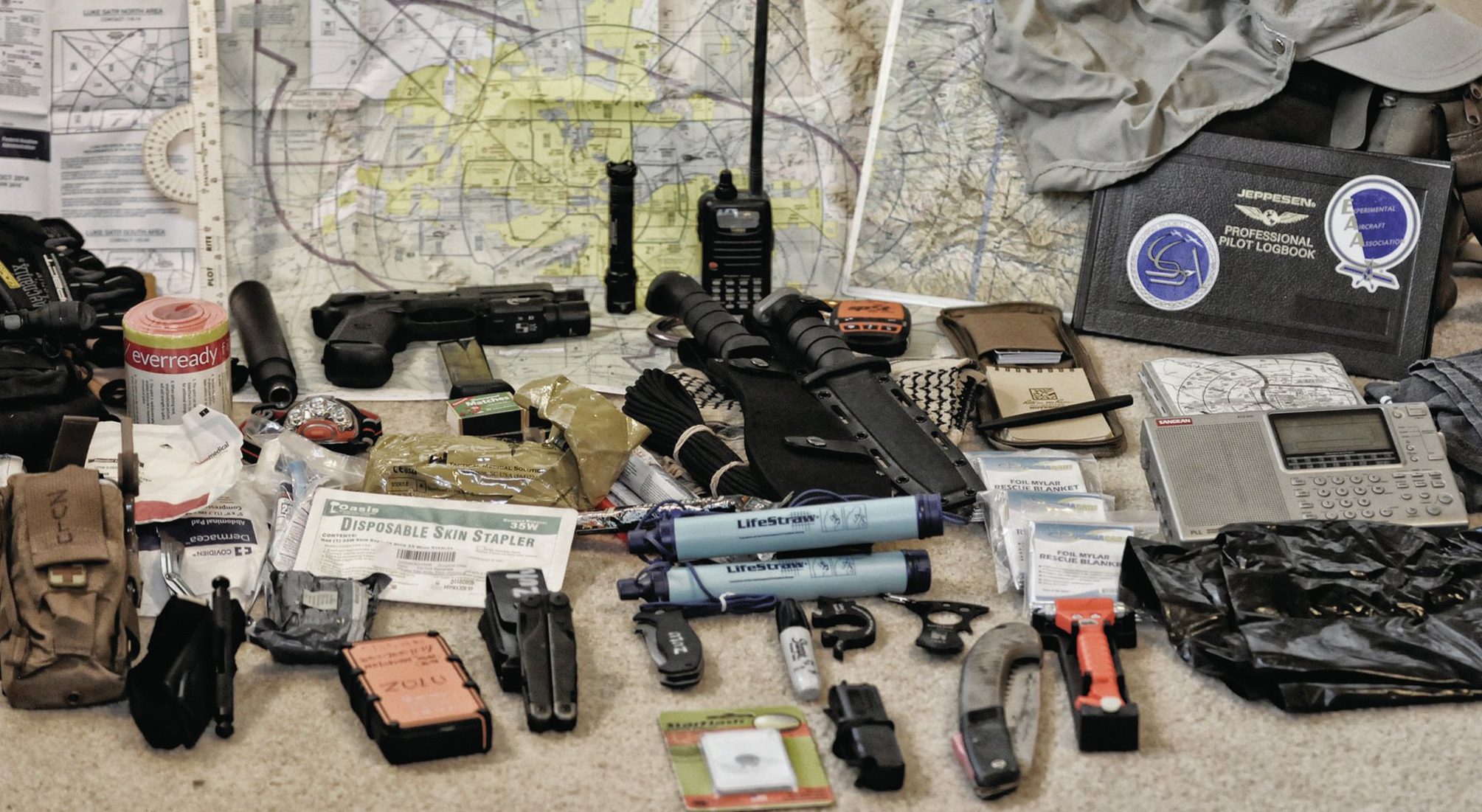My Perspective on Bug-Out Field Gear, by H.H.


You can throw a couple of items in a backpack and say “I’m prepared”, but are you really? For everything you do to prepare, think through all the things that can go wrong. My wife says I’m too pessimistic, but being an engineer, I’ve been trained to think about what can go wrong. You don’t want the plane to fall out of the sky or the bridge to collapse.
The first rule is always have more than one way of doing something. I had heard (maybe attributed to Army Rangers or SEALs) “Two is one and one is none.” If you have one of something, let’s say a knife, and it breaks, now you have none. If you have two cans of food and one of them is bulging because the food spoiled, now you have none. Always have two of something or two ways of accomplishing the same thing.
So what do we need to survive? There are lots of lists on the Internet, but the basic four have been shelter, fire, water, and food. Some authors have five things and the order will vary. I used to say water, fire, shelter, and food. Since 2020, with COVID-19 and the forest fires in California, I now have five things, with the first being air.
For air, you need a mask of some kind. Get at least one N-95 mask per person. As a backup, you can get a bandana or a shemagh. They won’t eliminate all the pollutants but will give you some relief. Some have polyester in them, but 100% cotton is better because you can make char cloth and use it for starting fires. Bandanas can be cut into strips and used as cordage or to mark a trail. Liberty Mountain has a nice survival bandana with lots of survival tips printed on it. Depending on the region you are going to, you can get map bandanas, especially the National Parks.
Water
After air, the most important thing you need is water. If you shelter at home, the Cadillac water filter is the Berkey Water Filter System. It’s expensive to start, but the filters last for 6,000 gallons, making the cost about five cents per gallon. If you are just starting off, you can get a Britta pitcher for less than $20, but the cost per gallon is over twelve cents per gallon. For your backpack or Bug Out Bag (BOB), there are a variety of filter straws. A name-brand straw, such as Life Straw, will be about $15 and filter about 800 gallons. They say it removes bacteria such as e-coli and salmonella as well as protozoa such as giardia (“beaver fever”). There are cheaper straws on Amazon that can filter about 150 gallons for $5. So again, the low-cost solutions can get you going, but the larger, more expensive solutions are actually cheaper per use. Iodine tablets are also used for purifying water and take up very little space. Besides filtering, you can also boil water if you have a metal cup and a fire.
Fire
Now we need fire. This is actually easy to do at a very low cost and easier than rubbing two sticks together. Rubbing sticks is the last thing you want to do. It’s hard!! First, get a cheap lighter like a Bic. Spin the wheel and light a fire. What if it gets wet? Not good! Put it in a ziplock bag before you put it in your BOB. After a while, the flint will get really short and when you spin the wheel, the flint comes out. Backup plan. Get a ferrocerium rod. They are made of iron, magnesium, and four rare earth metals. These are really great and they work well. Lots of Youtube videos on using it. Don’t get a little short one; they are too hard to work with. Get one that’s three inches long or longer. You can get a four-inch ferro rod with striker and nine feet of paracord for a lanyard on Amazon for under $15. It’s always good to have paracord, there are hundreds of uses for it.
You can get a nice fire-starting kit from Steve Kaeser that has everything you need: A ferro rod, striker, fatwood, jute cord soaked with soy, all in a tin can that fits in your pocket. Less than $15 on Amazon. This is a nice thing, not only in your BOB, but put one in the glove compartment of all of your cars, trucks, ATVs, boats, etc. Made in USA.
Another way of starting a fire is with a magnifying glass. This is a little bit harder; you have to have a large enough magnifying glass, the sun has to be really shining, so it doesn’t work at night or during rain. Plus, it might break in your BOB. Still, you might want one wrapped in the blanket in your car. You do have a blanket in your car, right?
Besides fatwood and wood shavings, a great thing to use as tinder are cotton balls mixed with Vaseline. A half dozen of these in a zip lock bag takes up very little space. I would put the ziplock bag inside another zip lock bag in case one rips. They are kind of messy.
Another nice item for starting fires is 151+ proof rum, vodka, or Everclear. 80 proof is a little bit too low. I haven’t tried 100 proof. In addition to starting a fire, this is high enough alcohol content to act as a disinfectant if you don’t have a first aid kit with you. Another great use is for barter. When times get bad, there is bound to be some item you forgot or ran out of, and just about everybody after a few months of hardship might want a drink.
Knives
There are some one-week survival courses that put you out in the woods with only a knife, so if you only can have one thing with you, it has to be a good knife. A really good one. They can be expensive, but they will last a lifetime. There are more than 14 types of steel, different handle material, and there’s not one perfect knife. There are some excellent websites that have several pages explaining the choices. Expect to spend $150 to $400 for your lifetime knife. Your backup knife, in a different BOB, can be $50 to $200, but to get started, get something that is in the $20 to $50 range. You could also consider one of the multitools, but the knife part of it is small. However, there are a lot of obscure uses that will come up when you are out in the woods.
Mylar Blankets
Foil Mylar Thermal Blankets are great! You can get ten inexpensive ones for less than twelve dollars and they have many uses. The cheap ones may tear easily, and are not puncture-proof. But they are still good to have in each of your bug-out bags. Some uses for your Mylar blanket are:
1) Blanket The most obvious use is as a blanket. It reflects most radiated body heat while protecting against wind and rain.
2) Tent shield Closely related, you can put one between your tent and the rain fly which will make the tent a lot warmer. It also protects it somewhat from rips and tears.
3) Before you pitch your tent, put one on the ground and then put branches, moss, sleeping bag, etc. over it. This will keep the cold ground from ruining your night.
4) Pick up all four corners and create a makeshift water bucket. Or simply a container for carrying berries, moss, kindling back to camp.
5) You can cut strips and weave them together for light cordage
6) Cut a hole in the middle and use it for a quick poncho. Your legs might get wet, but your core will stay warm and dry.
7) You can use it to capture water. Dig a hole and put the blanket in the hole with a small rock in the middle and rocks around the edges. When it rains, you will collect the water.
8) A flat piece with a hole in the middle is good for signaling searchers or aircraft. Look through the hole to see where the reflection is.
9) They also make a good heat reflector near your campfire.
10) Cut into long, thin strips, you can use them as trail markers or as a
Scarecrow for birds and wildlife of any kind.
So put one in each bug out bag, all of the glove compartments, etc.
Finally, where do you store your bug-out bag(s)? If you have only one bug-out bag in your house and there is an earthquake, the roof and walls might collapse on your bag and you can’t get to it. (I live in California)
So you really want at least two bug-out bags. You can divide up all the items in a thoughtful fashion. For example, for fire-starting, one bag would have a ferro rod or the Kaeser kit, and the other would have the Bic lighter. Maybe one is stored in the garage right next to a door to the outside, and the other is stored on the other side of the house near the patio door.
References
Something that never would have come up 20 years ago is a Kindle Reader! Why a Kindle? Two reasons: One, you will forget some good tips, and two, after a few weeks or months, you get bored. You could take 50 survival books with you and when stored electronically they take up very little space and weigh less than a pound. Also, the more complicated books you need to read over and over. An example would be “Where There is No Doctor” by Werner. He is a doctor, and covers some things that are beyond first aid. What to do when there are no hospitals around and you have to perform emergency surgery? This is not Bushcraft 101. It is a 402 course!
I hope this has given you some new things to think about. If you ever need your bug-out bag, hopefully you will have two of everything that don’t become one, but if they do, you’re prepared.
